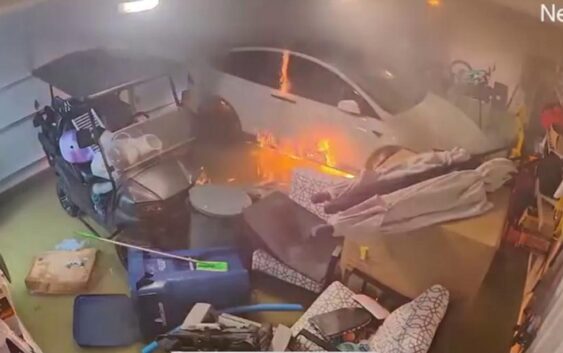- Western NC wildfire risk will 'get worse, not better' Ag Commissioner says, pressing lawmakers for help
- Watering trees is a must to protect them from severe weather and drought
- At least 4 dead, hundreds rescued after deadly floods ravage South Texas
- Today on Texas Standard: Deadly floods swamp South Texas, shatter records
- North Carolina radio station was a critical lifeline after Hurricane Helene. Then it became the voice of recovery.
Tesla catches fire after garage floods during Hurricane Helene

Officials are warning people to not store their electric vehicles inside their houses or garages.
PINELLAS COUNTY, Fla. — Pinellas County officials are warning residents to be careful with their electric vehicles after one caught fire in a garage during Hurricane Helene.
Pinellas County Government posted a video from a home security camera that showed the bottom of the car catching on fire from the saltwater and soon the car is engulfed in flames and the garage is completely filled with smoke.
Officials advised residents to not charge, drive or store electric vehicles or electric bikes in homes or garages and to move them 50 feet away from other combustible material.
In the past during storms like these, a vast majority of fires start because of saltwater intrusion into the home’s power supply. When electricity comes back on, it can surge, causing a fire. The lithium-ion batteries inside of electric vehicles can spark a fire when mixed with saltwater.
On Davis Islands in Tampa, a large, up-scale house was destroyed after a fire burned it down on Blanca Avenue. Tampa Mayor Jane Castor flew over the home and said she believed an electric vehicle may have been the cause of the fire.
Another fire sparked not far from there, where an electric vehicle is suspected of being a cause.
Hurricane Helene left behind a historic storm surge to coastal and low-lying areas across Pinellas County. It blew ashore in Florida’s Big Bend region as a Category 4 storm late Thursday and moved up through Georgia, the Carolinas and Tennessee.
The surge pushed 6 to 15 feet of water into coastal neighborhoods and nine people who drowned were residents who stayed behind after their Tampa Bay area neighborhoods were ordered to evacuate.